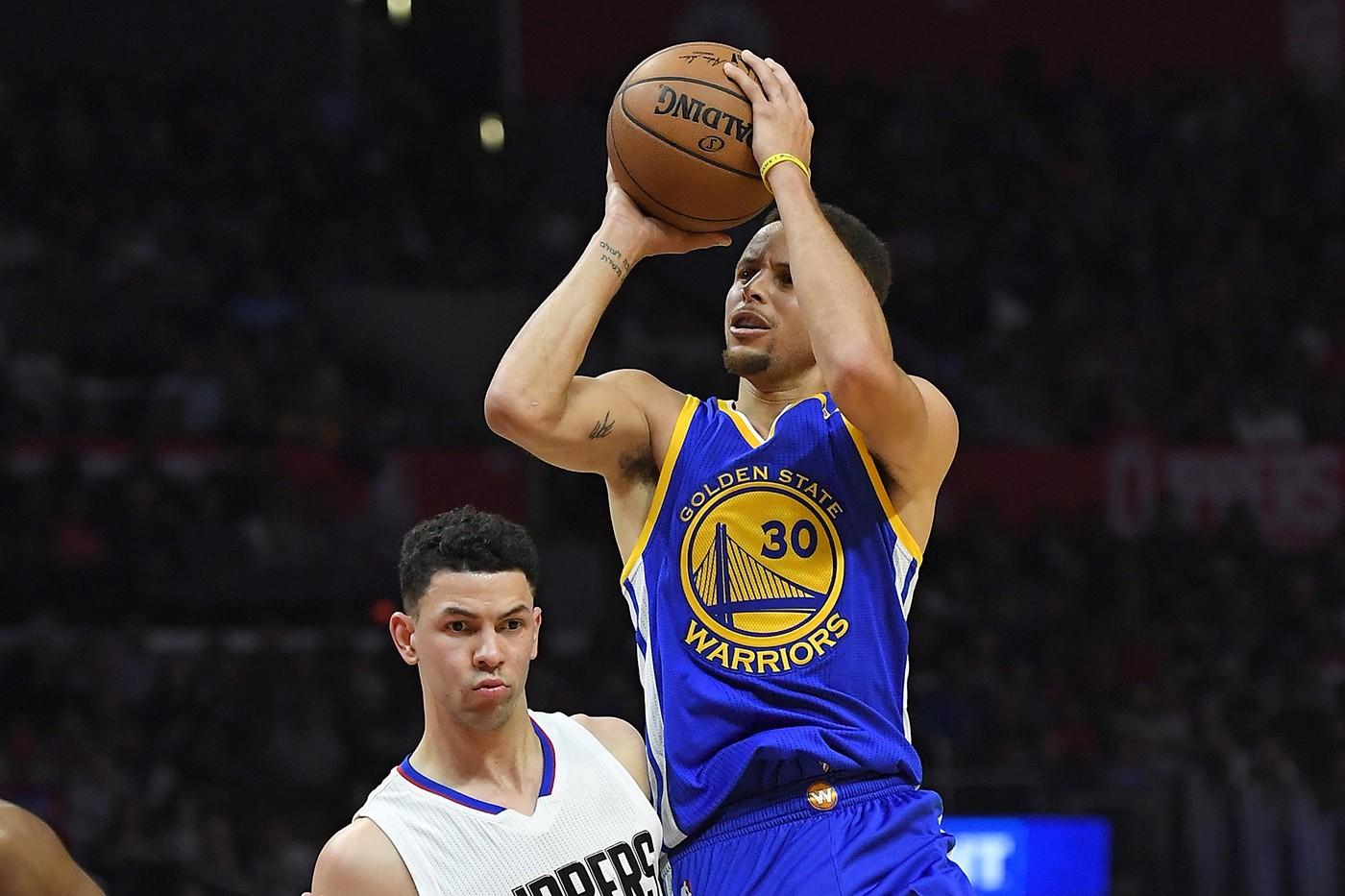
The first matchup between the Warriors and the Clippers was supposed to be the early game of the season. The Warriors (plus-13.8) and the Clippers (plus-9.6) came into the game with the two highest average point differentials in the NBA, while the 17 best two-man pairings in the league by net rating play for one of the two teams. With the best bench of the Lob City era, the Clippers looked as capable as any team in the league of giving the Warriors a game. Instead, they were run out of the gym in a 115–98 blowout that was over by the end of the first quarter, when the Warriors were up 37–19. For fans of competitive basketball, it was kind of depressing.
This used to be one of the most compelling rivalries in the NBA, but it appears to have peaked three seasons ago, when the Clippers knocked the Warriors out in an epic, seven-game first-round series that cost Mark Jackson his job. Ever since Steve Kerr took over and Draymond Green moved into the starting lineup, Golden State has owned its rivals to the south. The Warriors have now won seven straight games against the Clippers, and the level of competitiveness is trending in the wrong direction, as the past two games have been blowouts after three straight nail-biters at the start of last season.
You never want to take too much away from one regular-season game in December, but there’s a lot Doc Rivers and the Clippers coaching staff are going to need to figure out to give the team a chance if these two teams end up meeting in the playoffs. Here are five things that stood out from this game:
1. Blake Griffin Struggled to Score on Draymond Green
If it wasn’t clear before the game, it’s clear now: The Clippers don’t have as much star power as the Warriors. Their Big Three is going up against a Big Four, and one of their Big Three is a defensive-minded center who can’t create his own shot. In other words, they need Blake Griffin and Chris Paul to play as near-perfect versions of themselves to have any chance of knocking off Golden State. Instead, what the Clippers got out of Blake on Wednesday was a near triple-double in points, rebounds, and turnovers. He was soundly outplayed by Draymond.

Doc ran a bunch of isolations for Griffin to get him going early in the first quarter, but they went nowhere against Green. At first glance, it would seem that Blake, at 6-foot-10, would have a big advantage over Draymond, at 6-foot-7, with his back to the basket, but looks can be deceiving. Green actually has a significantly longer reach, with a 7-foot-1.25 wingspan compared to 6-foot-11.25 for Blake, which means he can contest the shot without leaving his feet. And while he isn’t quite as big, his listed 230 pounds is denser, packed onto a smaller frame than Blake’s 250, so it’s almost impossible for Blake to dislodge him when he’s established position in the post.
The only time Blake had any success on Draymond was when he faced him up and shot the ball from the perimeter. Any time he tried to back him down in the post, it ended up looking something like this:
The Clippers repeatedly went to this matchup and got almost nothing out of it. Far too often it ended up in a turnover, with the Warriors racing down the floor the other way and getting an easy basket:
2. The Clippers’ Transition Defense
If there’s a positive the Clippers can take away from this game, it’s knowing there’s no way the team’s transition defense will be that bad the next time they meet the Warriors. They gave up 27 fast-break points to Golden State, and scored only 11 of their own, a disparity which accounted for almost the entire difference in the final score. The Warriors were pushing the ball after every miss, and the Clippers never seemed able to get enough men back to contest shots. While a lot of those points came off terrible turnovers where the Clippers tried risky cross-court passes that had little chance of going through, they only lost the turnover battle 14–11, and only generated three fewer points off turnovers than the Warriors did. There were just too many possessions like this one, where the Warriors beat them over the top as if they weren’t even there:
3. To Stagger or Not to Stagger
When it comes to how they manage their rotations over the course of the game, there couldn’t be two coaches with more polar opposite philosophies than Doc Rivers and Steve Kerr. Doc is as old school as it gets, preferring to keep his starters together for as many minutes as possible, and spending large portions of the game with five reserves in. Kerr is much more liberal with his substitution patterns, mixing and matching his first and second units in order to keep one or two of his stars in for the entire game.
Both coaches played their starting five for a little over 12 minutes on Wednesday, and Kerr ended up using 17 total lineups compared to 14 for Rivers. But that’s where the similarities ended as far as how they opted to manage their respective teams. Before garbage time (defined as the final 2.9 minutes of the game when no Warriors starter was on the floor), the Warriors played only 2.8 minutes without either Kevin Durant or Steph Curry — but both Draymond and Klay Thompson were in the game during those sequences. Durant played nine minutes without Curry, and Curry played 10.5 minutes without Durant. The Clippers, on the other hand, played 15.5 minutes without Griffin or Paul, while Paul played 1.6 minutes without Griffin, and Griffin played only 0.3 minutes without Paul. Rivers tried anchoring second units for small stretches with either DeAndre Jordan or J.J. Redick, but he mostly kept his reserves in, even against the Warriors stars.
The Clippers reserves actually didn’t play all that terribly in those matchups, and they had much better individual plus-minus numbers than any of the team’s starters. The Clippers’ problems on Wednesday began with their starters getting badly beaten by their counterparts in Golden State on both sides of the ball, as they were minus-14 in their 12 minutes together. Nevertheless, some of the matchups that resulted from Rivers’s substitution patterns seemed less than ideal, including a stretch in both halves when Curry and Durant were on the floor together against the Clippers bench. Playoff games can be won or lost in two- or three-minute sequences, and it’s hard to see how Marreese Speights guarding Curry or Durant in pick-and-rolls is ever going to be a good idea:
4. The Clippers Switched Everything
From a strategic perspective, the biggest adjustment the Clippers made in this game is they switched almost all of the Warriors’ pick-and-rolls. That was the big adjustment that opposing teams started to make against the Warriors in last season’s playoffs, and there were very few of the signature Draymond 4-on-3 situations off of dump-offs from Steph in the game on Wednesday. Given Blake and DeAndre’s foot speed, the Clippers have the personnel upfront to at least try to switch everything, and it worked reasonably well.
Plays like this are the best-case scenario for the Clippers, when DeAndre ends up trapping Steph on the baseline and forces him to give up the ball without creating an advantage anywhere else on the floor:
Just as important is the reverse side of the matchup, with the Clippers perimeter players guarding the Warriors big men. This strategy was a lot less risky last season, when the switch left a smaller player on Draymond or Harrison Barnes, instead of Durant. What’s interesting is that Paul has generally given Durant trouble on defense, including one memorable playoff game in 2014 when Paul held Durant in check for most of the fourth quarter in a win over OKC. Paul is so much shorter than Durant that he can get into his dribble, and his low center of gravity makes it hard for Durant to push him off spots. Durant ended up settling for a lot of low-percentage shots with Paul on him:
The Warriors found the most success against the switch when they kept running their offense instead of going to isolations, taking advantage of the random matchups all over the floor to scramble the Clippers’ help-side rotations. This is something the Clippers should be able to clean up with more practice:
5. The Warriors’ Matchup Advantages
The Clippers are built around the strength of their starting five, one of the most dominant units in the league, but the Warriors are the rare team that can overwhelm them with skill and physicality across the board. The only pronounced edge in length and athleticism they have over the Warriors is at center with DeAndre Jordan over Zaza Pachulia, and that was the only position where they decisively won the individual matchup on Wednesday. Paul and Redick are essentially a smaller and less explosive version of the Splash Brothers, while Durant and Draymond have a huge edge in shooting and defensive versatility over Luc Mbah a Moute and Griffin. The Clippers might have an advantage on the bench, but the way Kerr structures his rotation, their reserves almost never get the chance to go up against the Warriors without the help of one of their superstars. The Clippers just have no margin for error, while the Warriors have a massive one.
The scariest part of this game for L.A. is that Golden State didn’t play all that well, at least on offense. Durant, Steph, and Klay combined to shoot 20-for-51 (39 percent) while the Warriors as a team shot only 7-for-30 (23.3 percent) from 3. It didn’t matter because the Warriors took their defense to another level, and they won the game going from defense to offense and scoring in the open court. The Warriors are breaking records with their no. 1-rated offense, but their defense, currently ninth in the league, still has some catching up to do. If they are locked in on that side of the ball, and they play as well defensively as they did on Wednesday, it’s going to be hard for anyone to beat them.

